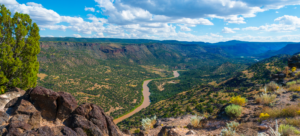
By Bjorn Fredrickson, New Mexico Wild Conservation Director
My father is a Ph.D. physicist who regaled me with stories growing up about the brilliant minds that worked at Los Alamos National Laboratory and were integral to expanding the boundaries of science and human knowledge — luminaries such as J. Robert Oppenheimer, Niels Bohr, Richard Feynman and others.
Today, LANL is disregarding modern innovations and proposing to use antiquated, early 20th century technology to build a new transmission line across the Caja del Rio. Officials say the two existing transmission lines that serve LANL are inadequate in meeting forecasted power and electric grid needs.
This is problematic. The Caja is of deep cultural significance to pueblos and tribes in New Mexico and beyond, and to the traditional Hispano communities that surround the plateau. With the ever-expanding creep of development and an intensifying climate crisis, it is also an essential sanctuary for wildlife. Modern-day recreationists flock to the Caja, too, to seek solace in nature.
The Santa Fe National Forest, which manages the core of the Caja, has recognized these values by designating the Caja del Rio Wildlife and Cultural Interpretative Management Area in its recently revised Forest Plan. The construction of a transmission line through the heart of the Caja would irreversibly damage these values by destroying cultural resources and sacred sites, fragmenting critical wildlife habitat and opening remote parts to the plateau to illegal abuses of the land that visitors to the edge of the Caja nearest Santa Fe know all too well.
Fortunately, there is a better way. In its 2020 report, “Advanced Transmission Technologies,” the Department of Energy, which oversees LANL, found:
“Advanced overhead conductors” (AOHCs) fabricated with new composite materials can carry up to double the electrical current of conductors (electric lines) used in traditional transmission lines.
A reconductoring project (the replacement of a conductor) using the advanced overhead conductors typically costs half or less as much as the construction of a new transmission line and can be planned, permitted and constructed in far less time.
Traditional conductors sag in hot weather, increasing the risk of power outages and wildfire. Such conductors experience less sag and are better at withstanding stress from high winds, ice and heat.
This all means that using advanced overhead conductors to reconductor one of the existing transmission lines serving LANL could increase transmission capacity by an amount equal to the construction of a new transmission line, would avoid irreversible impacts to the Caja’s treasured cultural and natural resources, and would save significant taxpayer dollars.
Despite these benefits, LANL would likely claim that reconductoring using advanced overhead conductors would not meet their need to increase the redundancy of their electrical supply. This is not exactly true — LANL’s new transmission line is proposed to originate at the Norton Substation, which is the source of an existing line serving LANL. An outage at or upstream of the substation would therefore impact both transmission lines. Because advanced overhead conductors are more reliable than conventional conductors, reconductoring may actually be the best alternative to maximizing the resiliency of LANL’s electrical supply.
Advanced overhead conductors are increasingly used abroad, but their adoption has been slower in the United States. LANL should return to its roots of scientific excellence and reconductor an existing transmission line to meet its needs. This would not only protect the Caja but also demonstrate how to undertake badly needed, cost-effective and efficient grid improvements as electric demand is projected to skyrocket nationally. We as a community along with the Forest Service and Bureau of Land Management, from which LANL must obtain permits for their proposed transmission line, should demand they do so.
Bjorn Fredrickson is the conservation director at New Mexico Wild, a nonprofit organization that works to protect New Mexico’s wildlands, wildlife and water. He is based in Albuquerque.
This op-ed was published in the Santa Fe New Mexican on May 25, 2024.

